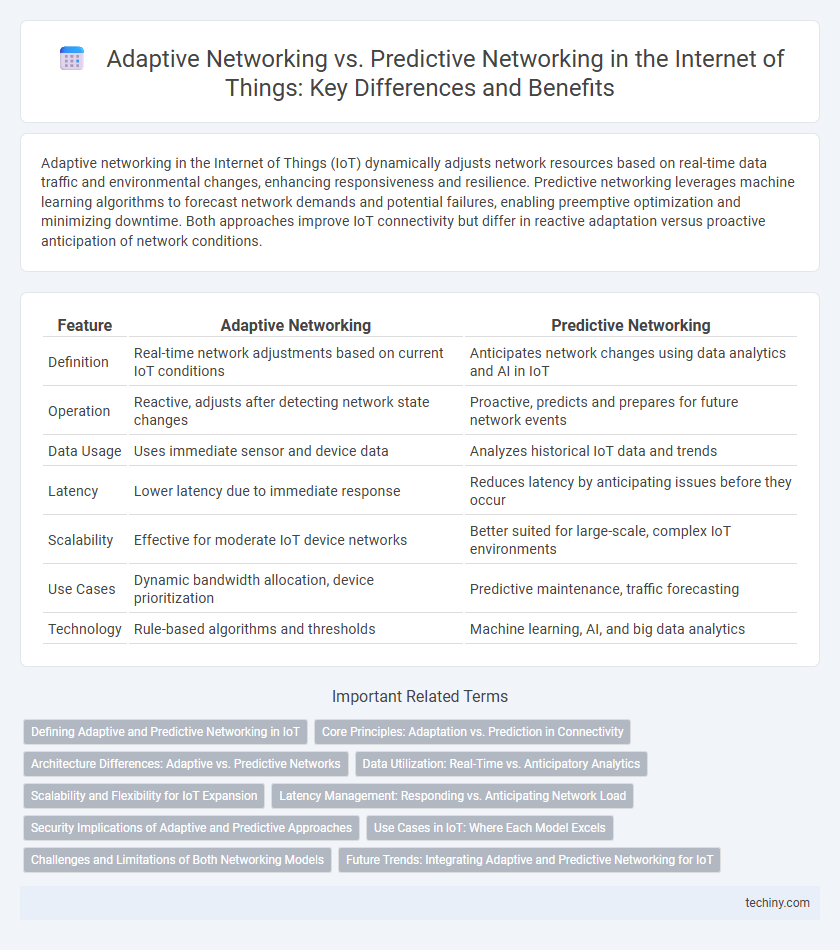Adaptive networking in the Internet of Things (IoT) dynamically adjusts network resources based on real-time data traffic and environmental changes, enhancing responsiveness and resilience. Predictive networking leverages machine learning algorithms to forecast network demands and potential failures, enabling preemptive optimization and minimizing downtime. Both approaches improve IoT connectivity but differ in reactive adaptation versus proactive anticipation of network conditions.
Table of Comparison
| Feature | Adaptive Networking | Predictive Networking |
|---|---|---|
| Definition | Real-time network adjustments based on current IoT conditions | Anticipates network changes using data analytics and AI in IoT |
| Operation | Reactive, adjusts after detecting network state changes | Proactive, predicts and prepares for future network events |
| Data Usage | Uses immediate sensor and device data | Analyzes historical IoT data and trends |
| Latency | Lower latency due to immediate response | Reduces latency by anticipating issues before they occur |
| Scalability | Effective for moderate IoT device networks | Better suited for large-scale, complex IoT environments |
| Use Cases | Dynamic bandwidth allocation, device prioritization | Predictive maintenance, traffic forecasting |
| Technology | Rule-based algorithms and thresholds | Machine learning, AI, and big data analytics |
Defining Adaptive and Predictive Networking in IoT
Adaptive networking in IoT dynamically adjusts network configurations based on real-time environmental data and device behaviors to optimize connectivity and performance. Predictive networking leverages machine learning algorithms and historical data to forecast network conditions, enabling preemptive adjustments that reduce latency and prevent disruptions. Both approaches aim to enhance IoT system reliability but differ in their reactive versus proactive management of network resources.
Core Principles: Adaptation vs. Prediction in Connectivity
Adaptive networking in the Internet of Things prioritizes real-time responsiveness by continuously adjusting network parameters to current environmental conditions and device behaviors. Predictive networking leverages machine learning algorithms and historical data to forecast connectivity demands and proactively optimize network resources. Both approaches enhance IoT efficiency, with adaptation focusing on immediate changes and prediction emphasizing future network states for improved performance.
Architecture Differences: Adaptive vs. Predictive Networks
Adaptive networking architecture in the Internet of Things dynamically adjusts communication paths and resource allocation based on real-time network conditions and device behaviors, ensuring robustness and resilience. Predictive networking architecture leverages machine learning and data analytics to forecast network congestion and device failures, enabling proactive adjustments before issues arise. These architectural differences highlight adaptive networks' reactive flexibility contrasted with predictive networks' anticipatory optimization for IoT environments.
Data Utilization: Real-Time vs. Anticipatory Analytics
Adaptive networking in the Internet of Things leverages real-time data utilization to dynamically adjust network parameters based on current conditions, enhancing immediate responsiveness and resource allocation. Predictive networking employs anticipatory analytics by analyzing historical and contextual data to forecast network demands and optimize performance before issues arise. Both approaches improve IoT efficiency, with adaptive networking excelling in instantaneous data handling, while predictive networking provides strategic foresight through data-driven predictions.
Scalability and Flexibility for IoT Expansion
Adaptive networking enhances IoT scalability by dynamically adjusting network resources based on real-time device activity, ensuring efficient connectivity as the number of IoT devices grows. Predictive networking leverages machine learning algorithms to forecast network demands, enabling proactive resource allocation that optimizes flexibility during rapid IoT expansion. Combining adaptive and predictive approaches facilitates seamless scaling and robust flexibility, supporting diverse IoT applications and heterogeneous device environments.
Latency Management: Responding vs. Anticipating Network Load
Adaptive networking manages latency by dynamically responding to current network conditions, adjusting resources and routes in real-time to maintain optimal performance. Predictive networking reduces latency through anticipation of future network loads using machine learning algorithms and historical data, enabling proactive resource allocation before congestion occurs. Prioritizing predictive models enhances user experience by minimizing delays through early detection and avoidance of potential bottlenecks in IoT communication.
Security Implications of Adaptive and Predictive Approaches
Adaptive networking enhances IoT security by dynamically adjusting to real-time threats and network conditions, reducing vulnerabilities through continuous response mechanisms. Predictive networking strengthens IoT defenses by leveraging machine learning algorithms to foresee potential attacks and preemptively implement security measures. Both approaches improve threat detection and mitigation, but adaptive networking excels in immediate response, while predictive networking offers strategic foresight to prevent security breaches.
Use Cases in IoT: Where Each Model Excels
Adaptive networking excels in dynamic IoT environments such as smart cities and industrial automation, where real-time responsiveness to changing network conditions is crucial for maintaining connectivity and performance. Predictive networking is ideal for applications like predictive maintenance in manufacturing and intelligent traffic management, leveraging data analytics and machine learning to anticipate network demands and optimize resource allocation before issues arise. Each model enhances IoT efficiency by addressing specific needs: adaptive networking ensures immediate adjustment to network variability, while predictive networking improves long-term planning and proactive decision-making.
Challenges and Limitations of Both Networking Models
Adaptive networking in the Internet of Things (IoT) faces challenges such as resource constraints, dynamic network topologies, and latency issues, limiting its real-time responsiveness and scalability. Predictive networking encounters limitations in data accuracy, model complexity, and computational overhead, which can hinder effective anticipation of network conditions and lead to suboptimal performance. Both models struggle with security vulnerabilities and interoperability among heterogeneous IoT devices, impacting overall network reliability and efficiency.
Future Trends: Integrating Adaptive and Predictive Networking for IoT
Future trends in IoT emphasize the integration of adaptive and predictive networking to enhance connectivity and data management efficiency. Adaptive networking dynamically adjusts network configurations in real-time based on current conditions, while predictive networking uses machine learning algorithms to forecast network demands and potential disruptions. Combining these approaches enables IoT systems to proactively optimize performance, reduce latency, and ensure reliable communication across diverse devices and environments.
Adaptive Networking vs Predictive Networking Infographic

 techiny.com
techiny.com